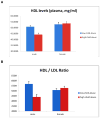The association between childhood trauma and lipid levels in an adult low-income, minority population
- PMID: 24315076
- PMCID: PMC3951665
- DOI: 10.1016/j.genhosppsych.2013.10.004
The association between childhood trauma and lipid levels in an adult low-income, minority population
Abstract
Background: The objective of this study is to investigate the association between childhood trauma and lipid profiles in adults from a highly traumatized population at-risk for cardiovascular disease.
Method: We recruited 452 participants, primarily African-American and of low socioeconomic status, from general medical clinics in a large urban hospital. We performed direct comparisons, univariate analysis of variance and regression analyses together and separated by sex, examining the associations of child abuse, body mass index, lipid lowering drug use, blood pressure, age, and substance use to HDL levels and HDL/LDL ratios.
Results: A history of moderate to severe levels of childhood trauma and abuse was associated with a significant decrease in HDL levels (P ≤ .01) and HDL/LDL ratios (P ≤ .001) relative to males with low levels of abuse. This relationship held when the status of lipid-lowering drugs was considered. When controlling for age, substance abuse, tobacco use, and adult trauma, the effects of childhood trauma remained significant. We found a significant child abuse by sex interaction on HDL/LDL ratios [F(1,369)=13.0, P ≤ .0005] consistent with a differential effect of trauma on dyslipidemia in male but not female subjects.
Conclusions: Our data suggest that childhood trauma exposure, obtained with self-report measures, may contribute to increased risk of cardiovascular disease by way of stress-mediated alterations of lipid concentration and composition in male, but not female, subjects.
Keywords: African-American; Cardiovascular; Genetic; Lipids; Trauma.
© 2013 Elsevier Inc. All rights reserved.
Figures

Similar articles
-
Exposure to Childhood Abuse and Later Substance Use: Indirect Effects of Emotion Dysregulation and Exposure to Trauma.J Trauma Stress. 2016 Oct;29(5):422-429. doi: 10.1002/jts.22131. Epub 2016 Sep 13. J Trauma Stress. 2016. PMID: 27622844 Free PMC article.
-
Current status and future directions in lipid management: emphasizing low-density lipoproteins, high-density lipoproteins, and triglycerides as targets for therapy.Vasc Health Risk Manag. 2010 Mar 3;6:73-85. doi: 10.2147/vhrm.s8725. Vasc Health Risk Manag. 2010. PMID: 20234782 Free PMC article. Review.
-
Cumulative burden of lifetime adversities: Trauma and mental health in low-SES African Americans and Latino/as.Psychol Trauma. 2015 May;7(3):243-51. doi: 10.1037/a0039077. Psychol Trauma. 2015. PMID: 25961869 Free PMC article.
-
Association between childhood maltreatment and adult emotional dysregulation in a low-income, urban, African American sample: moderation by oxytocin receptor gene.Dev Psychopathol. 2011 May;23(2):439-52. doi: 10.1017/S0954579411000162. Dev Psychopathol. 2011. PMID: 23786688 Free PMC article.
-
LDL-C:HDL-C ratio and common carotid plaque in Xinjiang Uygur obese adults: a cross-sectional study.BMJ Open. 2018 Oct 8;8(10):e022757. doi: 10.1136/bmjopen-2018-022757. BMJ Open. 2018. PMID: 30297348 Free PMC article.
Cited by
-
Inflammation, amygdala-ventromedial prefrontal functional connectivity and symptoms of anxiety and PTSD in African American women recruited from an inner-city hospital: Preliminary results.Brain Behav Immun. 2022 Oct;105:122-130. doi: 10.1016/j.bbi.2022.06.013. Epub 2022 Jun 27. Brain Behav Immun. 2022. PMID: 35772683 Free PMC article.
-
Adverse childhood experiences of Korean mothers with young children: a latent class analysis.Eur J Psychotraumatol. 2024;15(1):2372994. doi: 10.1080/20008066.2024.2372994. Epub 2024 Jul 10. Eur J Psychotraumatol. 2024. PMID: 38984740 Free PMC article.
-
Family Income Mediates the Effect of Parental Education on Adolescents' Hippocampus Activation During an N-Back Memory Task.Brain Sci. 2020 Aug 5;10(8):520. doi: 10.3390/brainsci10080520. Brain Sci. 2020. PMID: 32764344 Free PMC article.
-
Childhood adversity and cardiometabolic biomarkers in mid-adulthood in the 1958 British birth cohort.SSM Popul Health. 2022 Oct 4;19:101260. doi: 10.1016/j.ssmph.2022.101260. eCollection 2022 Sep. SSM Popul Health. 2022. PMID: 36238817 Free PMC article.
-
Association of adverse childhood experiences with lipid profiles and atherogenic risk indices in a middle-to-older aged population.SSM Popul Health. 2023 Apr 5;22:101393. doi: 10.1016/j.ssmph.2023.101393. eCollection 2023 Jun. SSM Popul Health. 2023. PMID: 37090689 Free PMC article.
References
-
- Sanchez MM. The impact of early adverse care on HPA axis development: non human primate models. Horm Behav. 2006;50(4):623–631. - PubMed
-
- Gunnar MR, Donzella B. Social regulation of the cortisol levels in early human development. Psychoneuroendocrinology. 2002;27(1–2):199–220. - PubMed
-
- Tarullo AR, Gunnar MR. Child maltreatment and the developing HPA axis. Horm Behav. 2006;50(4):632–639. - PubMed
-
- Carrion VG, Weems CF, et al. Diurnal salivary cortisol in pediatric posttraumatic stress disorder. Biol Psychiatry. 2002;51(7):575–582. - PubMed
-
- Williamson DF, Thompson TJ, Anda RF, Dietz WH, Felitti V. Body weight and obesity in adults and self-reported abuse in childhood. Int J Obes Relat Metab Disord. 2002;26(8):1075–1082. - PubMed
Publication types
MeSH terms
Substances
Grants and funding
LinkOut - more resources
Full Text Sources
Other Literature Sources

